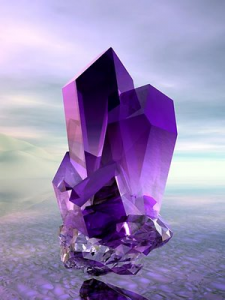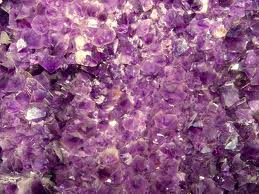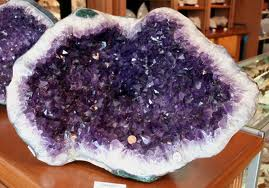Background on the Amethyst
The amethyst is extravagance in violet. For many thousands of years, the most striking  representative of the quartz family has been a jewel coveted by princes both ecclesiastical and secular. Moses described it as a symbol of the Spirit of God in the official robes of the High Priest of the Jews, and the Russian Empress Catherine the Great sent thousands of miners into the Urals to look for it. In popular belief, the amethyst offers protection against drunkenness – for the Greek words ‘amethystos’ mean ‘not intoxicated’ in translation
representative of the quartz family has been a jewel coveted by princes both ecclesiastical and secular. Moses described it as a symbol of the Spirit of God in the official robes of the High Priest of the Jews, and the Russian Empress Catherine the Great sent thousands of miners into the Urals to look for it. In popular belief, the amethyst offers protection against drunkenness – for the Greek words ‘amethystos’ mean ‘not intoxicated’ in translation
A large number of further miraculous powers are attributed to the amethyst in all sorts of cultures. It was said to protect crops against tempests and locusts, bring good fortune in war and in the hunt, drive out evil spirits and inspire the intellect. A little study of the works of Pliny will reveal that this gemstone, if worn round the neck on a cord made from dog’s hair, affords protection against snakebite. Later, Hieronymus even reported that eagles placed an amethyst in their nest in order to protect their young from the selfsame danger. Apart from these powers, gemstone therapists say that the amethyst has a sobering and cleansing effect. But the amethyst not only had a firm niche in medicine; it was also esteemed as a stone of friendship. And since it was thought to put the wearer in a chaste frame of mind and symbolize trust and piety, the amethyst came to occupy a very prominent position in the ornaments of the Catholic clergy over the centuries. It was the stone of bishops and cardinals; we find it in prelates’ crosses and in the so-called Papal Ring (Italian, 15th century) in the Jewellery Museum in Pforzheim.
The deposits with the greatest economic significance are in various states in southern Brazil and in neighbouring Uruguay. The third major export country is Madagascar. However, this gemstone is spread all over the world. Good specimens were found in Aztec graves, though the deposits from which they were extracted are no longer known today. On the Canadian side of Lake Superior in North America, there is a place named Amethyst Harbor. In Tibet there were amethyst rosaries, for there the gemstone was dedicated to Buddha and was said to promote clarity of mind. In Sri Lanka, stones which have rolled down on their own are found in debris.
In ancient times, amethyst was already being engraved and cut into sculptured forms, witness the bust of Trajan which Napoleon captured in Berlin. Amethyst quartz, banded with whitish layers, is particularly good to work with, though it is only ever either translucent or opaque or somewhere in between. In earlier times, people liked to drink wine from amethyst cups, which brings us back to the stone’s protective function against alcoholism. According to the ancient Greek saga, Diana turned a nymph whom Bacchus loved into an amethyst; hence the term Bacchus stone. Anyone wishing to protect a drunkard from delirium mixed some pulverized amethyst into the person’s drink.

